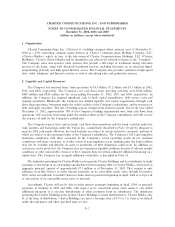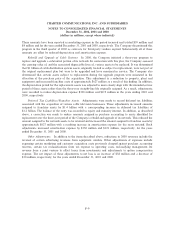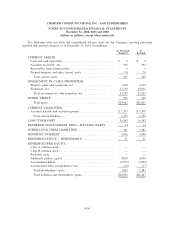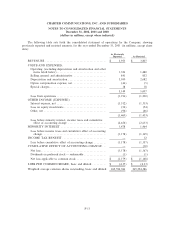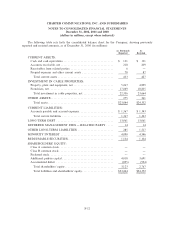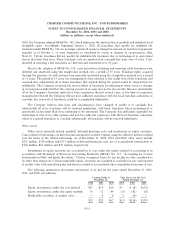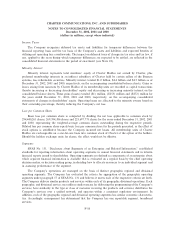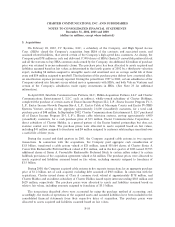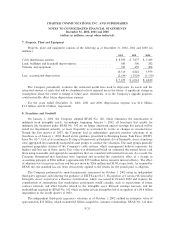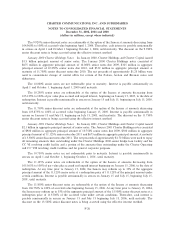Charter 2002 Annual Report Download - page 85
Download and view the complete annual report
Please find page 85 of the 2002 Charter annual report below. You can navigate through the pages in the report by either clicking on the pages listed below, or by using the keyword search tool below to find specific information within the annual report.
CHARTER COMMUNICATIONS, INC. AND SUBSIDIARIES
NOTES TO CONSOLIDATED FINANCIAL STATEMENTS
December 31, 2002, 2001 and 2000
(dollars in millions, except where indicated)
amount of launch incentives, included in other long-term liabilities, totaled $210 million, $215 million and
$126 million, respectively.
Advertising Costs
Advertising costs, including advertising associated with the launch of cable channels, are generally
expensed as costs are incurred. Advertising expense was $74 million, $52 million and $60 million for the years
ended December 31, 2002, 2001 and 2000, respectively.
Stock-Based Compensation
The Company has historically accounted for stock-based compensation in accordance with Accounting
Principles Board (APB) Opinion No. 25, ""Accounting for Stock Issued to Employees,'' and related
interpretations, as permitted by SFAS No. 123, ""Accounting for Stock-Based Compensation.'' On January 1,
2003, the Company adopted the fair value measurement provisions of SFAS No. 123 using the prospective
method under which the Company will recognize compensation expense of a stock-based award to an
employee over the vesting period based on the fair value of the award on the grant date consistent with the
method described in Financial Accounting Standards Board Interpretation No. 28 (FIN 28), Accounting for
Stock Appreciation Rights and Other Variable Stock Option or Award Plans. Adoption of these provisions will
result in utilizing a preferable accounting method as the consolidated Ñnancial statements will present the
estimated fair value of stock-based compensation in expense consistently with other forms of compensation
and other expense associated with goods and services received for equity instruments. In accordance with
SFAS No. 148, the fair value method will be applied only to awards granted or modiÑed after January 1, 2003,
whereas awards granted prior to such date will continue to be accounted for under APB No. 25, unless they
are modiÑed or settled in cash. Management believes the adoption of these provisions will not have a material
impact on the consolidated results of operations or Ñnancial position of the Company. The ongoing eÅect on
consolidated results of operations or Ñnancial position will be dependent upon future stock based compensation
awards granted by the Company. Had the Company adopted SFAS No. 123 as of January 1, 2002, using the
prospective method, option compensation expense for the year ended December 31, 2002 would have been
approximately $20 million.
SFAS No. 123 requires pro forma disclosure of the impact on earnings as if the compensation expense for
these plans had been determined using the fair value method. The following table presents the Company's net
loss and loss per share as reported and the pro forma amounts that would have been reported using the fair
value method under SFAS 123 for the years presented:
Year Ended December 31,
2002 2001 2000
Net loss applicable to common stock (in millions)ÏÏÏÏÏÏÏÏÏÏÏÏ $(2,517) $(1,168) $(858)
Pro forma ÏÏÏÏÏÏÏÏÏÏÏÏÏÏÏÏÏÏÏÏÏÏÏÏÏÏÏÏÏÏÏÏÏÏÏÏÏÏÏÏÏÏÏÏ (2,571) (1,226) (878)
Loss per common shares, basic and diluted ÏÏÏÏÏÏÏÏÏÏÏÏÏÏÏÏÏÏ (8.55) (4.33) (3.80)
Pro forma ÏÏÏÏÏÏÏÏÏÏÏÏÏÏÏÏÏÏÏÏÏÏÏÏÏÏÏÏÏÏÏÏÏÏÏÏÏÏÏÏÏÏÏÏ (8.73) (4.55) (3.89)
The fair value of each option granted is estimated on the date of grant using the Black-Scholes option-
pricing model. The following weighted average assumptions were used for grants during the years ended
December 31, 2002, 2001 and 2000, respectively: risk-free interest rates of 3.6%, 4.7%, and 6.5%; expected
volatility of 64.2%, 56.2% and 43.8%; and expected lives of 3.3 years, 3.7 years and 3.5 years, respectively. The
valuations assume no dividends are paid.
F-17


